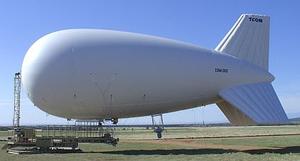BlimpsTCOM’s aerostat systems help U.S. Border Patrol
Several TCOM aerostat systems are being evaluated by Border Patrol agents in operational environments along U.S.-Mexico border. TCOM’s aerostat systems enable operators to view activity along the border. The system can typically remain aloft for two weeks to one month at a time. With operational altitudes of up to 5,000ft, the aerostats provide monitoring of thousands of square miles.

TCOM aerostats are being tested along the U.S. - Mexico border // Source: tcomlp.com
Columbia, Maryland-based TCOM, a specialist in airborne persistent surveillance solutions, is helping DHS improve U.S. Border Patrol operations in the Rio Grande Valley in Texas. Several TCOM aerostat systems are being evaluated by Border Patrol agents in operational environments along U.S.-Mexico border. TCOM’s aerostat systems enable operators to view activity along the border.
“TCOM’s tactical aerostats are ideal for the geography in southwest Texas,” stated TCOM president Ron Bendlin. “The elevated perspective offers broader reaching surveillance than ground systems can provide, and the mobility of the aerostat system enables operators to quickly and easily relocate the system when needed.”
The U.S. Border Patrol is now receiving assets, including TCOM’s 17M and 22M tactical class aerostats, and 38M operational class aerostats, to aid in detection and tracking efforts throughout highly trafficked areas along the U.S.-Mexico border.
Each aerostat system carries a payload of advanced sensor equipment, the same type of sensor equipment that Border Patrol agents use elsewhere. The system can typically remain aloft for two weeks to one month at a time. With operational altitudes of up to 5,000ft, the aerostats provide monitoring of thousands of square miles. This range and detailed data provide the actionable intelligence Border Patrol agents need to make decisions and keep the U.S. border region safe.
The company notes that tactical and operational TCOM aerostat systems consist of an aerodynamic helium-filled balloon which typically carries radar, video, and communications payloads aloft to altitudes ranging from 1,000ft up to 5,000ft. Payload data is then transmitted to a ground control station through a fiber optic tether providing secure transmission of high bandwidth data. The system operates round-the-clock, enabling Border Patrol forces gain situational awareness and identify illegal activity with enough time to evaluate and intercept.
“TCOM has provided aerostat systems to support U.S. and allied military operations in Iraq and Afghanistan for the past decade,” added Bendlin. “Now, we’re honored to be able to apply our proven expertise in support of border security efforts right here at home.”
